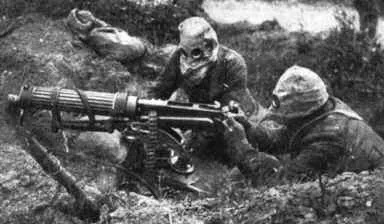Warfare of WWI |
| Introduction |
| Trench Warfare |
| New Weapons |
| Industrialization |
| Total War |

-
Machine Guns: Among the most devastating weapons introduced during the Great War were machine guns. These rapid-fire weapons had the capacity to mow down large numbers of troops in a short period. Machine guns such as the Maxim and the Vickers became prominent on the battlefield, creating a lethal curtain of fire that forced soldiers to seek cover and adopt new strategies.
-
Artillery: Artillery underwent significant advancements during World War I. Traditional cannons were replaced with more efficient and accurate artillery pieces, including howitzers and long-range guns. The use of high-explosive shells and gas-filled projectiles inflicted mass destruction upon enemy positions and trenches, reshaping the concept of entrenched warfare.
-
Poison Gas: Perhaps one of the most feared and notorious weapons used in World War I was poison gas. Introduced by both sides, gases like chlorine, phosgene, and mustard gas caused unimaginable suffering and casualties. These toxic agents lingered in the air and inhaled by soldiers, leading to severe respiratory problems, blindness, and death. The introduction of gas masks became vital for survival on the battlefield.
-
Tanks: World War I witnessed the debut of armored vehicles known as tanks. Initially slow and mechanically unreliable, tanks proved effective in breaking through enemy lines, overcoming barbed wire obstacles, and providing mobile cover for infantry. The British Mark series and the German A7V were among the earliest tank models deployed in battle.
-
Aircraft: Aviation technology rapidly advanced during the war, leading to the use of aircraft for reconnaissance, aerial combat, and strategic bombing. Fighter planes like the British Sopwith Camel and the German Fokker Dr.I revolutionized air warfare. Bombing raids carried out by large aircraft such as the Gotha G.V inflicted significant damage on enemy targets, including cities and industrial centers.
-
Submarines: World War I witnessed the increased use of submarines or U-boats in naval warfare. The German Navy employed submarines to devastating effect, employing unrestricted submarine warfare tactics. U-boats targeted enemy supply ships, leading to significant losses and challenging the naval dominance of the British Empire. This development resulted in the eventual entry of the United States into the war.
World War I marked a turning point in the history of warfare, witnessing the emergence and widespread use of a range of new weapons and technologies. The introduction of these innovative instruments of destruction not only transformed the battlefield but also had profound implications for the tactics, strategies, and human cost of the war.